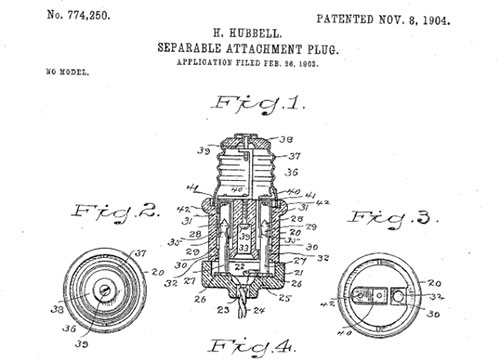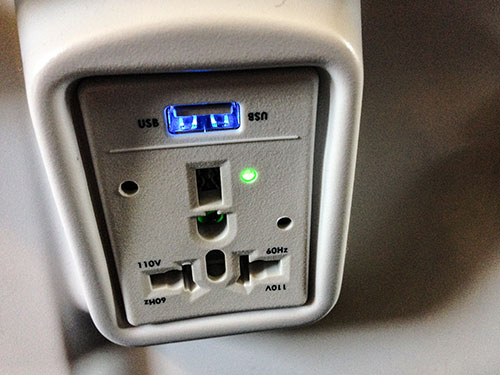Plug It In, Plug It In
Want to charge your phone in a new country? Better bring an adapter with you. Why are power outlets so frustrating? Blame bad decisions made decades ago.
250k

Before there were outlets, lights were directly wired into walls
If you had a house lit by electricity around the turn of the 20th century and wanted to move the furniture around your home, you probably wouldn't have been able to do that all too easily.
That's because, for the first couple of decades after the invention of electricity, electric power meant lighting, and lighting was hard-wired into the walls, requiring the literal tearing down of walls to move things around.
Obviously, that sucks, but fortunately inventors were working on the issue. In the 1890s, electric plugs were already being put into use in Europe, and in the early years of the 20th century, inventor and manufacturer Harvey Hubbell came up with an easy way for users to unplug a light bulb from a socket and replace it with another device fairly easily. Here's the reasoning for Hubbell's approach, according to his 1904 patent filing:
My invention has for its object to provide a separable attachment-plug in which the cost of construction shall be reduced to the minimum and which shall do away with the possibility of arcing or sparking in making connection, so that electrical power in buildings may be utilized by persons having no electrical knowledge or skill in the use of tools in attaching lights, fans, motors, heating apparatus, surgical instruments, or any of the various appliances requiring the use of an electric current to fixtures in the circuit, the removable parts being interchangeable and one of said parts being connected to each light, group of lights, fan, or other appliance which it may be required to place in the circuit.
Hubbell's approach took some time to win over a broader audience, in part because it required other manufacturers to sign on to the concept, and in part because homes were not wired for wall-based plugs—meaning that, if you wanted to plug into you home's electric current, you had to pull out a light bulb and replace it with a plug. But by the early 1910s, Hubbell plugs and competing variants slowly gained prominence, beating the approach encouraged by Edison's company—the use of attachment plugs, which used light sockets as plugs.
Five types of outlets you may run into as an intrepid world traveler
- In the United States and much of the Americas, most power outlets use a fairly compact two-prong or three-prong outlet, which evolved from the Hubbell plug. Eventually, it gained a grounding plug as a way to prevent electric shock, thanks to the help of an engineering student from Milwaukee. Japan uses a roughly similar layout for its plugs, but with some slight differences, including differences in voltage and a heavier reliance on the two-prong standard.
- The United Kingdom perhaps has the bulkiest and most unusual plug type, one significantly larger than any other kind you'll run into around the world. But that size and design actually of huge benefit, because it means that it's basically impossible to get electrocuted by a UK power outlet, unlike its American counterpart. It's incredibly well-designed. However, an older plug that isn't nearly as well-designed still remains in use in former British colonies such as India.
- Outside of the UK, most countries in Europe have small variations in the ways that their plugs work, but most travelers throughout Europe don't have issues with this because the plugs generally have a consistent two-prong setup. Most European countries use the "Schuko" format, which was introduced in Germany in the 1920s, but variations specific to France, Denmark, and Switzerland add their own weird twists. Fortunately, the Europlug standard used for many devices ensures that travelers aren't totally screwed if trying to travel between countries.
- Israel and Palestine might not have a lot of common ground on many diplomatic and political issues, but one place where they agree is with their unusual three-pronged electrical outlets, which feature a grounding prong close to the center of the plug. It's compatible with the Europlug, fortunately.
- There are plenty of other variations, but the most interesting is that of Australia and China, where the most common type of power outlet features slanted plugs. It's roughly similar in size to the U.S outlet—in large part because the design was originally based on a patented Harvey Hubbell design.
15

Why are there so many standards?
To put it simply, it comes down to decisions that were made very early in the process.
Different countries use different types of voltage, and did so without keeping in mind the fact that, y'know, people might want to travel around the world and plug in their iPad no matter what country they're in.
The U.S., for example, standardized on the 120-volt system at a 60 Hz frequency, but at the same time, Germany was making up its mind that a 220 to 240-volt system at 50 Hz was a better idea. And in Japan, half the country uses 60 Hz while the other half uses 50 Hz—something that created big headaches and ensured that inconsistencies between the various systems abounded. These inconsistencies followed their way to the outlets as well.
"There are standards, and there is a plug that has been designed," the International Electrotechnical Commission's Gabriela Ehrlich explained to Gizmodo in 2009. "The problem is, really, everyone's invested in their own system. It's difficult to get away from that."
So we're stuck, basically.
"What’s the worst that could happen? You could get electrocuted and die. Barring that, it is very unlikely that electronics will be damaged by these sockets. But high-power electric devices could overload the socket and blow a fuse."
— Blogger Stephen Foskett, explaining how "shavers only" outlets, often found in hotel rooms outside of the U.S., can actually handle more than just electric shavers—but not much more. In countries outside of North America, 220-240 volt energy is more common, but that level is dangerous for using devices in a restroom, due to the fact that there's water nearby. The solution? These countries use low-power outlets that limit the amount of energy that can reach your electric shaver, ensuring that you won't get electrocuted and die. Foskett notes that plugging in a laptop to these ports is probably a bad idea.
In a lot of ways, the real solution to this giant mess of cables and connections might be the tech industry's trojan horse: the USB port. It's a simple format that is smaller than all electric outlets and offers up just enough power to give nearly all small devices the proper push. And it's already in wide use.
Over the years, USB has become an accepted standard for computer cables, but also a de facto standard for electric charging—thanks in large part to a move by most mobile phone makers to embrace micro-USB as a standard port. And a USB cable is likely to work with any kind of laptop or outlet, no matter if you're in Menlo Park or Madagascar. It's common these days to find wall outlets with USB ports built right in, and even airplanes have started to offer built-in USB ports on long-haul flights.
In a way, USB is the stealthy comeback game of direct current. See, nearly all electronic devices rely on DC power to operate, due to the fact that DC power is considered more consistent than AC power for certain energy needs. That's why AC adapters are so common.
In other words, Edison might still win over Tesla after all.
:format(jpeg)/2018/04/tdenptebgqyebmzbquzj--1-.gif)
/2018/04/tdenptebgqyebmzbquzj--1-.gif)

/uploads/ernie_crop.jpg)